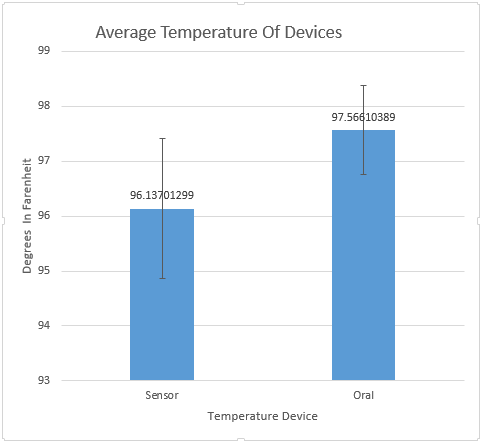BME100 f2013:W1200 Group8 L3
| Home People Lab Write-Up 1 | Lab Write-Up 2 | Lab Write-Up 3 Lab Write-Up 4 | Lab Write-Up 5 | Lab Write-Up 6 Course Logistics For Instructors Photos Wiki Editing Help | ||||||
|
OUR TEAM
LAB 3A WRITE-UPDescriptive StatisticsAverages: Sensor:96.13701299 degrees Fahrenheit Oral:97.56610389 degrees Fahrenheit
Standard Deviation: Sensor:1.280723306 Oral:.8053509188
ResultsAnalysisThe null hypothesis states that the thermometer temperature is the same. The alternative hypothesis states that the temperatures vary. The average temperature for the oral sensor is 97.566, and the standard deviation of the oral sensor is .805. The average for the external sensor is 96.137, and the standard deviation of that is 1.280.From this data we concluded that the external sensor is not as effective as the oral senor.The p value was 8.83326E^-22, stating that there is nearly a zero percent chance that they are the same. This can be rationalized because the P value we got is less than 0.05 The correlation between the sensor and oral thermometer was .050573103, showing little to no correlation between the two.
Summary/DiscussionResults, Analysis,and Conclusion
Flaws and Recommendations
LAB 3B WRITE-UPTarget Population and NeedOur target population will be the parents of children. They will want to keep their child safe and healthy, so we will advertise parents about making sure their child doesn't have high fever if they are sick. The parents can then use their Smart Phone to use our temperature device to keep track of their child's body temperature. They can then send this information directly to their pediatricians for their files on the child. This will save an extra trip to the doctors office for making sure that the child doesn't have a high fever.
Device DesignSince almost everyone has a smart phone we will design an app that goes along with a plug in at the bottom of their device. This device will have a sensor that can read the skin temperature of the patient. It will then feed that information to the app for data collection. The device will have a smooth sensor that rolls across the skin on the forehead. Moving the sensor across the skin of the forehead three times will give you an accurate reading. Phonometer: Accessibility, Dependability, Every ability (Picture)
Inferential Statistics
SET UP: This experiment was set up by monitoring a subject's temperature once every five minutes with the phonometer sensor, as well as with a standard thermometer. 3 temperatures were taken indoors, and 3 were taken outside.
Graphhttp://i39.tinypic.com/23nogh.png
| ||||||


